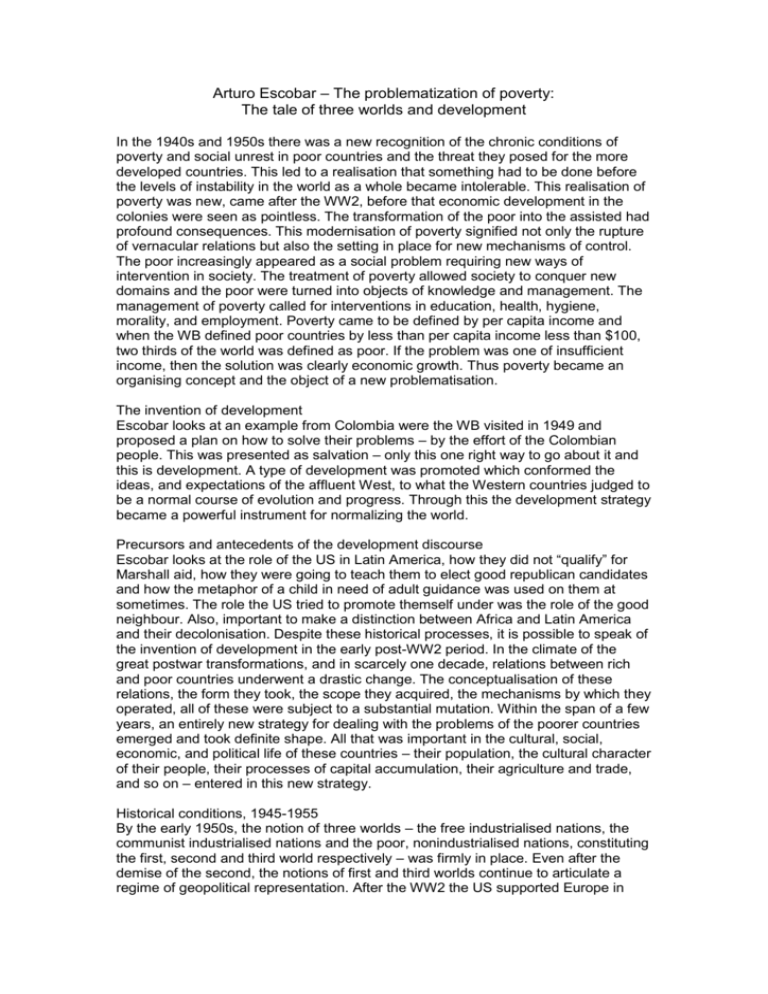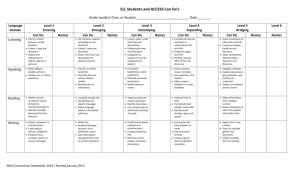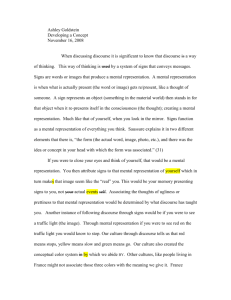TPP W9 Escobar
advertisement

Arturo Escobar – The problematization of poverty: The tale of three worlds and development In the 1940s and 1950s there was a new recognition of the chronic conditions of poverty and social unrest in poor countries and the threat they posed for the more developed countries. This led to a realisation that something had to be done before the levels of instability in the world as a whole became intolerable. This realisation of poverty was new, came after the WW2, before that economic development in the colonies were seen as pointless. The transformation of the poor into the assisted had profound consequences. This modernisation of poverty signified not only the rupture of vernacular relations but also the setting in place for new mechanisms of control. The poor increasingly appeared as a social problem requiring new ways of intervention in society. The treatment of poverty allowed society to conquer new domains and the poor were turned into objects of knowledge and management. The management of poverty called for interventions in education, health, hygiene, morality, and employment. Poverty came to be defined by per capita income and when the WB defined poor countries by less than per capita income less than $100, two thirds of the world was defined as poor. If the problem was one of insufficient income, then the solution was clearly economic growth. Thus poverty became an organising concept and the object of a new problematisation. The invention of development Escobar looks at an example from Colombia were the WB visited in 1949 and proposed a plan on how to solve their problems – by the effort of the Colombian people. This was presented as salvation – only this one right way to go about it and this is development. A type of development was promoted which conformed the ideas, and expectations of the affluent West, to what the Western countries judged to be a normal course of evolution and progress. Through this the development strategy became a powerful instrument for normalizing the world. Precursors and antecedents of the development discourse Escobar looks at the role of the US in Latin America, how they did not “qualify” for Marshall aid, how they were going to teach them to elect good republican candidates and how the metaphor of a child in need of adult guidance was used on them at sometimes. The role the US tried to promote themself under was the role of the good neighbour. Also, important to make a distinction between Africa and Latin America and their decolonisation. Despite these historical processes, it is possible to speak of the invention of development in the early post-WW2 period. In the climate of the great postwar transformations, and in scarcely one decade, relations between rich and poor countries underwent a drastic change. The conceptualisation of these relations, the form they took, the scope they acquired, the mechanisms by which they operated, all of these were subject to a substantial mutation. Within the span of a few years, an entirely new strategy for dealing with the problems of the poorer countries emerged and took definite shape. All that was important in the cultural, social, economic, and political life of these countries – their population, the cultural character of their people, their processes of capital accumulation, their agriculture and trade, and so on – entered in this new strategy. Historical conditions, 1945-1955 By the early 1950s, the notion of three worlds – the free industrialised nations, the communist industrialised nations and the poor, nonindustrialised nations, constituting the first, second and third world respectively – was firmly in place. Even after the demise of the second, the notions of first and third worlds continue to articulate a regime of geopolitical representation. After the WW2 the US supported Europe in keeping control over their colonies, with an eye on increasing their own influence. Their main concern in Latin America was firstly the growing nationalism. The US later totally misread the situation. Other factors shaping the development discourse; the cold war, the need to find new markets, the fear of communism and overpopulation and faith in science and technology. Find new markets and safe battlefields After 1945 a reorganisation of the structure of world power was taking place. The period 1945-1955 then, saw the consolidation of US hegemony in the world capitalist system. The need to expand and deepen the market for US products abroad, as well as the need to find new sites fir the investment of US surplus capital, became pressing during these years. One economic factor that became more noticeable during the period was the change in the relation of industrial production to the production of foods and raw materials, to the detriment of the latter, which pointed toward the need for an effective program to foster primary production in underdeveloped areas. Yet the fundamental preoccupation of the period was the revitalisation of the European economy. The third world was instructed to look at private capital, both domestic and foreign, which meant that the right climate had to be created, including a commitment to capitalist development; the curbing of nationalism, and the control of the left, the working class, and the peasantry. The cold war was undoubtedly one of the single most important factors at play in the conformation of the strategy of development. The historical roots of development and those of east-west politics lie in one and the same process: the political rearrangements that occurred after WW2. In the 1940s, the real struggle between east and west had already moved to the third world and development became a grand strategy for advancing such rivalry and, at the same time, the designs of industrial civilisation. The third world was central to superpower rivalry and the possibility of nuclear confrontation. The system that generates conflict and instability and the system that generates underdevelopment are inextricably bound. It was commonly accepted in the 50s that if poor countries were not rescued from their poverty, they would succumb to communism. The promise of science and technology The development of new sciences played an important role in the elaboration and justification of the new discourse of development. Science and technology had been the markers of civilisation par excellence. With the success of the Marshall help in Europe, modern technology and capital were seen as crucial to development. However, it relied much more heavily on technical assistance than on capital, in the belief that the former would provide progress at a lower price. Technology, it was believed, would not only amplify material progress, it would also confer upon a sense of direction and significance. Technology was seen as neutral and inevitably beneficial, not as an instrument for the creation of cultural and social orders. The earlier model for the generation of knowledge, organised around the classical professions according to 19th century usage, was replaced by the North American model (Keynesian macroeconomic, Parsonian sociology, etc.). Development had to rely on the production of knowledge that could provide a scientific picture of a country’s social and economic problems and resources. The unquestioned desirability of economic growth was, in this way, closely linked to the revitalised faith in science and technology. Economic growth presupposed the existence of a continuum stretching from poor to rich countries, which would allow for the replication in the poor countries of those conditions characteristic of mature capitalist ones (including industrialisation, urbanisation, agricultural modernisation, infrastructure, increased provision of social services, and high levels of literacy). Development was seen as the process of transition from one situation to the other. Another important factor that influenced the new strategy of development was public intervention in the economy. Behind the humanitarian concern and the positive outlook of the new strategy, new forms of power and control, more subtle and refined, were put in operation. Poor people’s ability to define and take care of their own lives was eroded in a deeper manner than perhaps ever before. The poor became the target of more sophisticated practices, of a variety of programs that seemed inescapable. The discourse of development Development as a created space in were only certain things could be said and imagined. - Modernisation as the only force - Industrialisation and urbanisation as the only way to modernisation - Capital investment as the most important ingredient Focused on: capital formation through technology, population and resources, monetary and fiscal policies, industrialisation and agricultural development, commerce and trade. Development was then the result of the establishment of a set of relations among these elements, institutions, and practices and of the systematisation of these relations to form a whole. The development discourse was constituted not by the array of possible objects under its domain but by the way in which, thanks to this set of relations, it was able to form systematically the objects of which it spoke, to group them and arrange them in certain ways, and to give them a unity of their own. To understand development as a discourse, one must look not at the elements themselves but at the system of relations established among them. It is this system that allows the systematic creation of objects, concepts, and strategies; it determines what can be thought and said. These relations – established between institutions, socioeconomic processes, forms of knowledge, technological factors, and so on – define the conditions under which objects, concepts, theories, and strategies can be incorporated into the discourse. The system of relations establishes a discursive practice that sets the rules of the game: who can speak, from what points of view, with what authority, and according to what criteria of expertise; it sets the rules that must be followed for this or that problem, theory, or object to emerge and be named, analysed, and eventually transformed into a policy or a plan. This discourse covered basically the entire cultural, economic, and political geography of the third world. Development proceeded with creating abnormalities (underdeveloped, illiterate, etc.) that it then could cure. Linked to this type of rationality, instruments of power and control came into being. Although the discourse have gone through a series of structural changes, the architecture of discursive formation laid down in the period 1945-1955 has remained unchanged, allowing the discourse to adapt to new conditions. The result has been the succession of development strategies and substrategies up to the present, always within the confines of the same discursive space. It is also clear that other historical discourses influenced particular representation of development, like communism. Similarly, patriarchy and ethnocentrism influenced the form development took. Indigenous populations had to be modernised, where modernisation meant the adoption of the right values – those held by the white/mestizo minority. Forms of power in terms of class, gender, race, and nationality thus found their way into development theory and practice. By 1955 a discourse had emerged which was characterised not by a unified object but by the formation of a vast number of objects and strategies; not by new knowledge but by the systematic inclusion of new objects under its domain. The most important exclusion was and continues to be what development was suppose to be all about: people. Development was and continues to be for the most part, a top-down, ethnocentric, and technocratic approach, which treated people and cultures as abstract concepts, statistical figures to be moved up and down in the charts of “progress”. Development was a system of more or less universally applicable technical interventions intended to deliver some badly needed goods to a target population. Conclusion The transformation that took place after WW2 made underdevelopment the subject of political technologies that sought to erase it from the face of the earth but that ended up multiplying it to infinity. At times, development became so important for third world countries that it became acceptable for their rulers to subject their populations to an infinite variety of interventions, to more encompassing forms of power and systems of control, so important that first and second world elites accepted the price of massive impoverishment. The forms of power that have appeared act not so much by repression but by normalisation, not by ignorance but by controlled knowledge, not by humanitarian concern but by the bureaucratisation of social action. As a discourse, development is thus a very real historical formation, albeit articulated around an artificial construct (underdevelopment) and upon a certain materiality (the conditions baptized as underdevelopment), which must be conceptualised in different ways if the power of development discourse is to be challenged or displaced. The coherence of effects that the development discourse achieved is the key to its success as a hegemonic form of representation: the construction of the poor and underdeveloped as universal, preconstituted subjects, based on the privilege of the representers; the exercise of power over the third world made possible by this discursive homogenisation and the colonisation and domination of the natural and human ecologies and economies of the third world.






